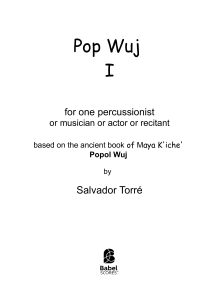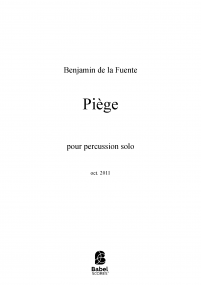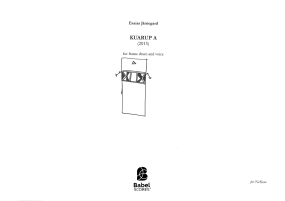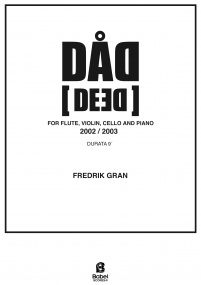Shadow Play
for percussion solo
7,21 €
Digital version (+0,00 €) instant download
Printed format (+14,80 € printing and shipping). Colissimo7-14 days aprox.
When you buy a score, you can contact the composer right here!
Specifications
Region
Oceania
Estimated Duration
11 - 15min
Date
2002
ISMN : 979-0-2325-1794-0
In Stock
Notes on this piece For a very “note”-based composer such as myself, few things are more terrifying than the prospect of writing a piece altogether without pitch. I began working on a solo percussion piece for untuned instruments in 1995, having chosen the medium as a deliberate challenge to myself: little did I imagine that it would take me seven years and several restarts to bring the project to completion!
While my early attempts were heavily focused on the rhythmic dimension, in its final form Shadow Play is primarily a piece about timbre and gesture. The setup calls for six pairs of instruments — woodblocks, triangles, cowbells, cymbals, tom-toms and bass drums — positioned in a mirror-symmetrical layout. In order to maximize the timbral variety possible, a wide range of mallets is used: the opening triangle duet, for example, is played with four different beaters, two in each hand. In addition, over the course of the piece one instrument in each pair (except the woodblocks) is muted, cutting most of its resonance and substantially altering its timbre.
The imagery of the title refers partly to the changing relationship between the two instruments of each pair, but also more generally to the work’s strategies of linking contrasting timbres within the one gesture. The music frequently combines sounds of very different dynamic levels in such a way that the soft sounds are not heard as events in their own right, but as shadowing or subtly altering the louder sounds to create composite events.
The composition of Shadow Play was assisted by the Commonwealth Government of Australia through the Australia Council, its arts funding and advisory body. Originally a joint commission for Australian percussionists Alison Eddington, Richard Gleeson and Sue Dennis, the impetus for the completion of the work came from Pablo Rieppi in New York: the score is therefore dedicated to all four of them.
Add to a playlist
- Login to create your own lists
While my early attempts were heavily focused on the rhythmic dimension, in its final form Shadow Play is primarily a piece about timbre and gesture. The setup calls for six pairs of instruments — woodblocks, triangles, cowbells, cymbals, tom-toms and bass drums — positioned in a mirror-symmetrical layout. In order to maximize the timbral variety possible, a wide range of mallets is used: the opening triangle duet, for example, is played with four different beaters, two in each hand. In addition, over the course of the piece one instrument in each pair (except the woodblocks) is muted, cutting most of its resonance and substantially altering its timbre.
The imagery of the title refers partly to the changing relationship between the two instruments of each pair, but also more generally to the work’s strategies of linking contrasting timbres within the one gesture. The music frequently combines sounds of very different dynamic levels in such a way that the soft sounds are not heard as events in their own right, but as shadowing or subtly altering the louder sounds to create composite events.
The composition of Shadow Play was assisted by the Commonwealth Government of Australia through the Australia Council, its arts funding and advisory body. Originally a joint commission for Australian percussionists Alison Eddington, Richard Gleeson and Sue Dennis, the impetus for the completion of the work came from Pablo Rieppi in New York: the score is therefore dedicated to all four of them.
Instrumentation
Percussions
Score Details
Format - A4 / US Letter
Pages - 24
Pages - 24













